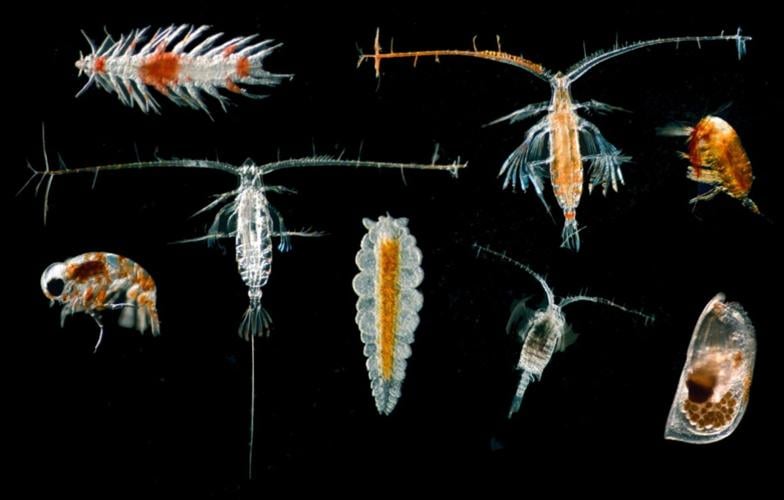
Zooplankton from the eastern Clarion Clipperton Zone. (Goetze, Ellis, Cazares via SWNS)
Deep-sea mining is threatening vital marine life in the ocean’s “twilight zone,” reveals new research.
The findings raise "urgent concerns" about long-lasting effects if large-scale commercial mining proceeds without strong environmental safeguards, say scientists.
For example, Pacific tuna fisheries operate in the zone - which means that deep sea mining waste could impact fish eaten by people around the world.
Waste particle plumes ejected by mining operations into deep Pacific waters threaten the food sources of more than half of zooplankton, according to the first study of its kind.
The problem is leading to "bottom-up" disruption of the zone's delicately balanced food system, say scientists at the University of Hawai‘i School of Ocean and Earth Science and Technology (SOEST).
The new study is the first to show that waste discharged from deep-sea mining operations in the Pacific’s biodiverse Clarion-Clipperton Zone (CCZ) could disrupt marine life in the midwater “twilight zone” - a vital region 200 to 1,500 metres (650 to 4,900 ft) below sea level that supports vast communities of zooplankton, tiny animals that serve as the ocean’s basic food building blocks.

Nodules on the abyssal seafloor in the Clarion Clipperton Zone with a mud cloud from a scientific remotely-operated vehicle (ROV) touching down. (UH/NOAA DeepCCZ Expedition via SWNS)
The findings, published in the journal Nature Communications, show that 53% of all zooplankton and 60% of micronekton, which feed on zooplankton, would be impacted by the discharge, which could ultimately impact predators higher up on the food web.
Study lead author Michael Dowd said: “When the waste released by mining activity enters the ocean, it creates water as murky as the mud-filled Mississippi River.
"The pervasive particles dilute the nutritious, natural food particles usually consumed by tiny, drifting Zooplankton.
“Micronekton, small shrimp, fish, and other animals that swim, feed on zooplankton.
"Some migrate between the depths and near-surface waters and they are consumed by fish, seabirds and marine mammals.
"Zooplankton’s exposure to junk food sediment has the potential to disrupt the entire food web.”
The study examines the content and effects of waste released during a 2022 mining trial in the midwater CCZ, an area of the Pacific Ocean targeted for the extraction of deep-sea polymetallic nodules, which contain minerals, including cobalt, nickel and copper.
Researchers collected and tested water samples from depths where the mining waste was discharged, finding that those particles had far lower concentrations of amino acids - a key indicator of nutritional value - than the naturally occurring particles that fuel life in these depths.
Study co-author SOEST Professor Erica Goetze, an expert in marine zooplankton ecology, said: “This isn’t just about mining the seafloor; it’s about reducing the food for entire communities in the deep sea.
“We found that many animals at the depth of discharge depend on naturally occurring small detrital particles - the very food that mining plume particles replace.”

Illustration on midwater impacts. (Drazen et al., 2020 via SWNS)
The study comes as some countries ramp up their efforts to meet growing global demand for metals needed for electric car batteries and other low-carbon technologies.
Currently, around 1.5 million square kilometres (580,000 square miles) of the CCZ are under license for deep-sea mining.
During the deep-sea mining process, nodules are collected from the seafloor, along with seawater and sediments, and transferred through a pipe to a collection ship for separation of nodules from sediment waste.
The seawater-containing sediment waste, as well as pulverised very small nodule particles, must be returned to the ocean.
Although the release depth for the waste is currently unclear, some mining operators have proposed midwater mining discharge within the twilight zone.
Until now, the impacts of the waste on midwater communities was little understood.
Scientists say the impacts will be critical for the establishment of regulations around waste discharge, which don’t yet exist.
They explained that the twilight zone hosts a "staggering" diversity of life - including tiny krill, fish, squid, octopus and gelatinous species such as jellyfish and siphonophores.
By rising towards the ocean’s surface every night, then swimming back down again, the species support the transport of carbon to greater depths in the ocean, which is critical to ocean and human health.
They either feed on the particles in the twilight zone or prey on those that do, creating a "tightly linked" food web that connects the surface ocean to the abyss.
Co-author SOEST Professor Jeffrey Drazen said: "Our research suggests that mining plumes don’t just create cloudy water - they change the quality of what’s available to eat, especially for animals that can’t easily swim away.








